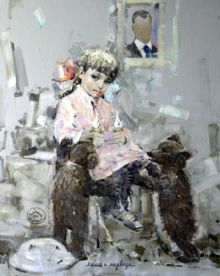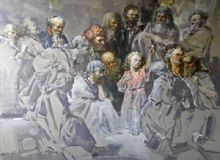Vladyslav Shereshevsky is a born artist and a true original. He is famous for his wit in traditional painting and quotations in pictures. His pictures are very “readable” for this reason or, maybe, because the artist was called stand-up comedian in school. His characters are sweet and ironic. His pictures are beautiful and funny at the same time. The Day spoke with what seems to be a totally unserious person about such important things as level of education, internalization and quality of contemporary Ukrainian art, and Ukraine’s place in the world of culture.
The collector and gallerygoer Marat Gelman claims that the atmosphere in Russia is not conducive to collecting objects of art. And what is the situation in Ukraine?
“In my view, things here are even worse than in Russia. As I know my collectors, I can say that they are now in dire straits: they are being robbed of property and money. They are not top oligarchs. They are intellectuals who have become businessmen. They were not born in Yenakievo. They are urban guys who are not grabbers and do not like kowtowing. I have thought throughout my lifetime that things are just about to improve. But, in reality, they were becoming still worse: the richest are willing to get still richer rather than to make life better. The number of collectors is not on the rise. The point is I deal with traditional painting, not ‘mod art.’ And understanding traditional painting is like understanding classical music. Are there many people who understand the latter? No. And will there be many people of the next generation who will frequent philharmonics? Still fewer.”
Pavel Makov claims that there is no Ukraine as a cultured country on the world’s map and just a few individuals will be unable to establish a reputation for it. Do you think there can be a well-known artist in an unknown country?
“This country is well known, but not for artists, even though they are of a very high level. It seems to me we basically work for ‘our own people.’ To break through onto the international level, we need a different public attitude. In Europe and America, the one who paints better-looking pictures makes a way up. They are not interested in our depth – all they need is a good surface layer.”
In this connection, I would like to ask if it was easy for you to reach the international level.
“Very difficult. The Germans ‘understood’ me, but Frenchmen and Italians did not, perhaps due to a more southern mentality. The Americans have been brought up on ‘McDonalds-type culture,’ so their perception is entirely different. The law also complicates the situation. It is more or less easy to take a picture out, but when you bring one in, you have to pay colossal money. Suppose I am taking 100 pictures to an official exhibit in London. Their price is listed in the insurance policy. When I am bringing in some pictures, I must pay 15 percent of their overall price or bribe the customs officers. There are no governmental investments at all. I do not even dream of hype-up campaigns which, for example, Chinese artists can afford – I just work hard and do my business very well. It is useless to try to conquer the world from Kyiv – you need to be in New York. I have wanted for a long time to conquer the world from here. I thought it was possible if I could arrange exhibits abroad. But the system turned out to be very simple: if you live in a village, you will never become a violinist in a philharmonic orchestra.”
Most of the great creators, including artists, have an idea which they incarnate in their oeuvres. What is your idea?
“It is difficult for me to say. In my childhood, there was a poster in my studio, which read: ‘You are first man, then artist.’ I may have drawn some conclusions from this, and now this idea is very simple: ‘Remain the artist.’ You should try to achieve a better result, being aware that the goal of your creative work is devotion rather than success and the fuss around it.”
But contemporary art is different…
“That’s why I call it ‘mod art.’ This art is a time-server made by juggler artists. This occurs because the entire worldwide spirituality is in degradation. Children stop reading books because they are developing in a different way. When you read, you think, but when you receive information from a computer, you are not developing. I was once worried that the next generation would paint worse and worse. Then I understood that this happens because nobody needs this. High levels are not needed. What is needed is a good mediocrity. There is no high level today because people do not perceive art – they have a weaker background in comparison with artists. Even collectors are lagging behind the artist by five years or so. Now they love my art of 1999-2003. They are saying: ‘You’ve done it better before.’ In reality, they are a bit lagging behind, even though they are people who know about art.”
To what extent is contemporary Ukrainian art comparable with the world level?
“A question to a wrong person, but I think it can be comparable. Our people are very talented, but youth have been educated differently: for them, the hype and money are more important than creative experimental activity. Many masters of contemporary art work in advertising companies, but I’ve been an artist throughout my lifetime. They arrange an exhibit within two days after a call from a certain curator. Then they go again to the advertising agency. While we are talking about the sense of life, they are making money. Hence are different mentalities. The artist’s laxity leads in the long run to successful projects.”
You have gone through a serious school. It is a popular opinion nowadays that limits are being placed on classical art education. Is the latter necessary for the “born artists” (this is exactly what is written on Shereshevsky’s visiting card)? Or will this kind of artist mature without it?
“There are no strict rules. There are a lot of artists without higher education, such as, for example, Isupov and Chichkan. At the same time, the Dutch system (if one is in art, he or she is exempt from paying taxes) has brought forth a million of weak uneducated artists. If you want to know about art, go to museums. See the works of Titian and Rembrandt. I once read in a magazine that we are sweeping away all that was before us. A thing like this occurred in 1917. But there are a large number of people who really understand art and can see what is what. To do so, they don’t need to look at ratings. There are 30 people of this kind in Kyiv and 1,000 in Moscow. These people are role models.”
What do you think about classical education in Ukraine today?
“It was one of the best in the world very recently, about 15 years ago. Now there is no sense in it. The profession is no longer prestigious, and the level in education, as well as in other spheres, has touched rock bottom. The artist is a profession for men and a condition of spirit, so it is impossible to teach it if there is no desire and the necessary milieu.”
And could you teach at our institution?
“I would have said ‘yes’ 10 years ago. But I have totally ossified now and work like an automaton. Those who teach at the [art] academy today are not the best artists. The root cause is that there were laughably low salaries in the 1990s. The students were the guys and girls who knew how to ‘hit it off’ with professors. As a result, you can count good teachers on the fingers of one hand. Is there anything to speak about if people do painting tests from cell phones? In plain words, an artist’s draped model sits for 40 hours, while they come on the last day, take photos, transfer and paint them on the canvas, get the necessary three points, and remain satisfied. Can this really produce anything?”
Let us go 10 years back, when you could have agreed to teach. What kind of a teacher would you have been?
“I’d have been a tough teacher, although I look relaxed and gentle now. To teach well, you must demand very much, but there are no stimuli for this. In my time, seven people competed for a place. Moreover, the applicants were art school leavers, not just people from the street. The profession was more prestigious. And now you can take lessons with a tutor for a couple of years and enter the institute.”
A popular debate is now underway on whether art should be social. What do you think of this?
“Art undoubtedly plays a social role. What I don’t like is that ‘mod art’ assigns people only one task – to surprise rather than to agitate, emphasize or look into. This resembles a circus: the clown shows a magic with small balls, you get surprised but cannot recall this the next day. Conversely, when you have seen a good theatrical production, you will digest it in your mind for several weeks. As Lenin said, cinema and circus should be the most important arts for us. Then the word ‘circus’ was crossed out. But, in the original, it sounded exactly like this.”
So you don’t like circus?
“I do like circus but not the art that surprises you and then makes you forget it. It is for small children. Its role has boiled down to one thing now – to surprise. By contrast, true art should deal with fundamental problems, such as life and death, love and hatred, instead of responding to ‘TV questions.’ It should not be as follows: something is on television today, in the Internet tomorrow, and on the picture The Day after tomorrow. I want my pictures to make people think. This surprises as well as stops one. I have a lot of quotations [in my picture]: they may not be clear to everybody, but those who need it will understand them.”









